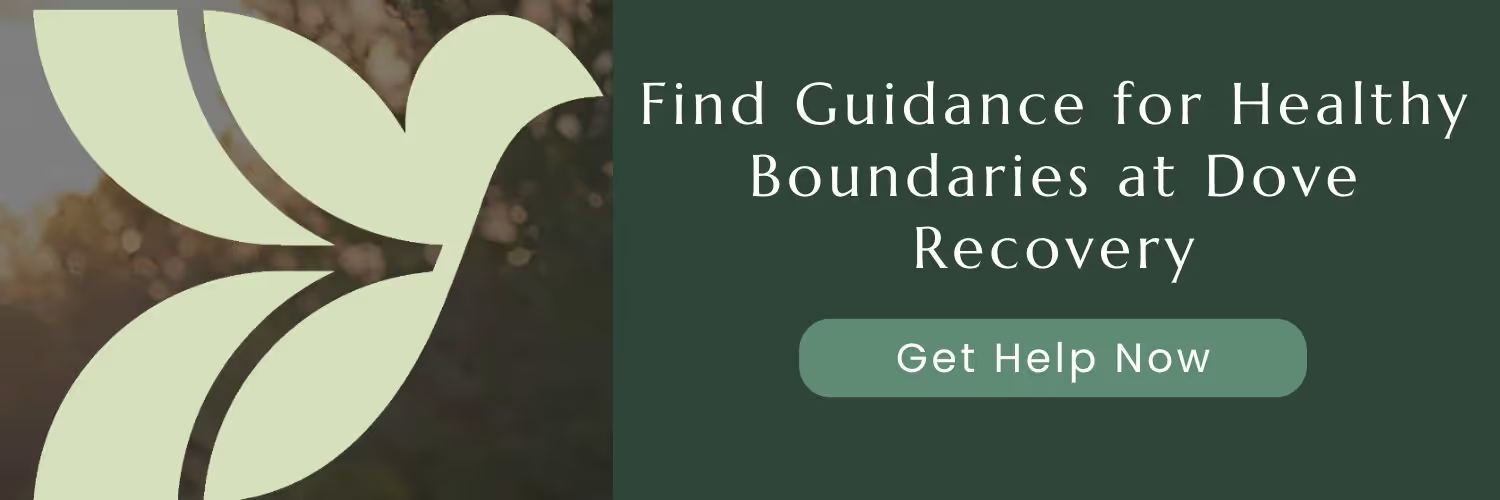Setting Boundaries in Recovery for Long-Term Success

Whether boundaries are physical or proverbial, crossing them can make or break you, especially when you are seeking to achieve or maintain sobriety.
Setting and adhering to boundaries is necessary for recovery, rebuilding relationships, and creating the healthy, stable life that you crave. It may not be easy to establish boundaries, but they are vital to the healing process.
Do you have codependent tendencies? Is there a part of a relationship that is purely toxic?
Boundaries create safe spaces that not only help the individual in recovery, but also for those around them. They serve as a line in the sand for what is acceptable and what is not.
Continue reading to understand more about setting healthy boundaries to achieve recovery and maintain long-term success.
Table of Contents
- Why Is Setting Healthy Boundaries in Recovery Necessary?
- What Are the 3 Steps To Setting Boundaries?
- What Are the 4 C’s of Boundaries?
- 5 Types of Boundaries To Set in Recovery
- Build Stronger Boundaries and a Lasting Recovery With Dove Recovery
Boundaries are essential for a variety of reasons.
Not only can they can protect your recovery process, but they help with:
- Creating a safe space from the outside world or any extrinsic influences
- Avoiding pressures or triggers that could send you into a relapse
- Removing toxic interactions and dynamics that can hinder your progress
- Allowing you to prioritize your own needs and well-being
How Boundaries Support Long-Term Recovery
Consider first how the lack of boundaries may have played a huge role in your addiction.
Addictions or substance dependencies often destroy any boundaries, as they can take over lives and prioritize the use of substances over any relationship, goals, or quality of life. The result can be a very damaged life.
Since blurred or absent lines for boundaries likely played an active part in addiction, what does setting healthy boundaries for long-term recovery look like?
- Having the power to say no when offered a drink or drugs.
- Limiting or ending relationships with those who are still using substances.
- Avoiding places that trigger cravings or negative memories.
- Exercising boundaries with loved ones, friends, or family members who deny or enable your harmful actions and behaviors.
What do healthy boundaries promote?
- Establishing healthy relationships with those who are supportive in your recovery.
- Allowing time for self-care.
- Boosting your self-esteem and confidence.
- Exercising self-control over your life and choices.
- Avoiding misunderstandings and conflicts by clearly communicating your needs and safe spaces.
The clinical team at Dove Recovery understands how vital it is to set healthy boundaries to maintain long-term recovery. Contact us today to begin one of our transformative programs and regain control of your life.

Step 1: Think About Your Needs
Take time to reflect on your needs. If you are confident in your needs, it is easier to stick to your boundaries.
Consider:
- What do I need more of?
- What do I need less of?
- What are my limitations?
- Physical
- Mental
- Emotional
- Time
Step 2: State Your Need
Clearly and firmly state your needs to those who need to hear them. Being assertive but respectful protects your well-being without being abrasive and accusatory.
Use “I” statements to avoid blame. For example, “I will not remain present around anyone who chooses to drink or use drugs.” Making statements about what is best for you may help to avoid confrontations.
Step 3: Accept Discomfort
In general, if a boundary involves a limitation set on an individual or a group of people, they may not be happy.
When setting boundaries for your own well-being, it is important to remember:
- You cannot be responsible for others’ reactions.
- There may be awkwardness induced in the relationship.
- You need to stand your ground and remain firm in your decision.
- You cannot allow others to manipulate or guilt you into actions you are trying to overcome.

There are 4 key components of communication, or boundaries, that provide a framework to effectively express your needs and wants.
- Clear communication
- Be sure to clearly state your preferences, needs, and boundaries.
- Confidence
- Demonstrate your convictions in your boundaries and your commitment to meet your goals.
- Comfort
- A comfortable setting or relationship encourages honest dialogues.
- Maintain an atmosphere where all people involved feel welcome to communicate their concerns.
- Connection
- Realize that boundaries are not set to create division, but to provide support to a relationship.
- Building an honest connection with another person promotes mutual understanding and perspective.
#1: Physical Boundaries
Physical boundaries may seem concrete to recognize, such as:
- Your body
- Your possessions; and
- Your personal space
A physical boundary may be as simple as removing substances from your presence.
On a more serious note, if physical abuse has been present, this may be difficult to establish at first, but establishing this boundary may be closely linked to your safety.
#2: Emotional Boundaries
Emotional boundaries can be tricky to decipher, as they may be intertwined with the feelings or beliefs of others around you.
Why did you or your loved one turn to substance? Was there a traumatic event? Is there a difficult and manipulative relationship? Will you feel guilted by someone else if you attempt to set an emotional boundary?
These boundaries may be more difficult to recognize and may only be identified well into treatment. As well as identifying the need for an emotional boundary, the baseline for this boundary may also fluctuate over time depending on relationships — those that are mended or ended.
#3: Time Boundaries
Time is precious, and people who have been dealing with addictions may realize this more than others.
Much time has been spent on pursuing addictions, and it may feel like a significant amount of time has been wasted in our relatively short lifespans. However, in recovery, there is a shift of time from time spent on pursuing addictions to more available free time.
This shift may be overwhelming, and boundaries need to be established quickly so the free time can now be focused on activities that will prevent relapses and support sobriety.
Consider the following ways to celebrate your time in sobriety:
- Attending support meetings
- Leisure activities
- Relaxation
- Self-reflection
- Healing or holistic practices
- Exploring new interests
- Spending time with supportive friends and family
#4: Relational Boundaries
In addiction recovery, relational boundaries are the healthy limits a person sets in their interactions with others to:
- Protect their sobriety
- Promote their own emotional well-being and safety
- Support their personal growth
- Maintain autonomy in their recovery
- Rebuild trust in relationships
Relational boundaries in recovery are about allowing space for healing while building healthier and more balanced connections. They help define what is acceptable — and what is not — in relationships, so that both parties know where responsibilities begin and end.
#5: Digital Boundaries
Digital boundaries are the rules and limits a person sets around their use of technology.
Technology is widely accessible, and may be a great help (or hindrance) in recovery, such as:
- Social media
- Exposure must be limited to triggering content.
- Supportive communities may be found on digital platforms.
- Privacy and communication
- Be sure to limit access to supportive friends and family only.
- Do not pursue late-night scrolling or secretive conversations that may trigger relapses.
- Content and triggers
- Limit content to avoid unnecessary temptations.
- Time management
- Set limits on technology to avoid escape-seeking tendencies or potential self-isolation behaviors.

Addiction is a progressive loss of control over the use of a substance or behavior. An individual becomes obsessed with the substance or behavior despite adverse consequences, and may deny the existence of a problem.
Addiction does not just affect the individual person — it is also damaging to families, relationships, careers, and many other aspects of life. Those dealing with symptoms of addiction may be ashamed of things they have done in the past, but they can seek treatment at Dove Recovery. Lasting recovery may be highly dependent on identifying and setting healthy boundaries — as difficult as it may be.
At Dove Recovery, professional counselors and therapists will accompany you on your sobriety journey without fear of judgment and with continual support, and will help you build a framework of strong boundaries.
Our supportive and seasoned staff members specialize in addiction recovery treatment. We offer customized treatment plans that cater to each client’s needs, using evidence-based approaches like:
- Psychotherapy sessions
- Dual diagnosis therapy
- Relapse prevention techniques
- Counseling and therapy
- Inpatient programs
- Outpatient programs
- Partial hospitalization programs
Dove Recovery offers a comprehensive range of services designed to help you at every step of your recovery and sobriety with customizable options to fit your needs.
Contact us today to begin setting healthy boundaries to achieve lasting recovery!

